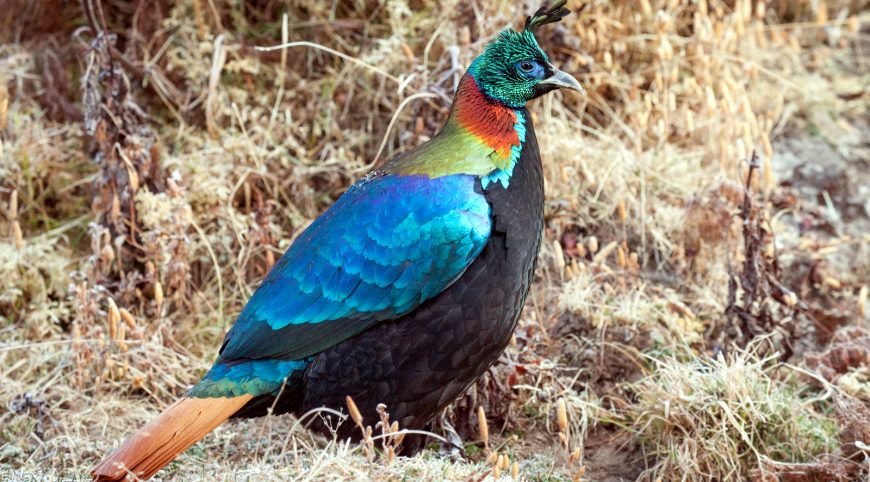
Yonzon and reports on Forktail, Journal of World Pheasant Association and Danphe Bird Conservation Nepal Newsletter). 1981) and some studies on these birds in the Indian Himalayas have been only reported in grey literature (e.g. Information regarding these three species within Nepal's Himalayas is limited and outdated, although several scientific studies exist (Gaston 1980 Gaston & Singh 1980 Gaston et al. Everest) National Park (SNP hereafter), in the Khumbu–Himal region of Nepal. Our study is focused on three high-altitude Galliform species: the Tibetan Snowcock Tetraogallus tibetanus (Gould, 1854), Blood pheasant Ithaginis cruentus cruentus (Hardwicke, 1821) and Himalayan monal in the Sagarmatha (Mt. Additionally, as with most birds, the species' activity peaks mainly at dusk and dawn. For instance, Himalayan monal, Lophophorus impejanus (Latham, 1790), a high-altitude Galliform, form groups during the autumn, while individuals are more scattered during the breeding season (Soldatini et al. When carrying out population estimate studies, it is important to consider the ecological characteristics of the species, such as the time of day the species is most active, the time of the year, and any flocking/grouping behaviour the species may exhibit. This implies the need to fully understand the behavioural ecology of a species before planning a field study for population estimates. Contrarily, Himalayan monal counts at dawn were far less representative of species abundance than dusk counts. Two different patterns emerged in the species studied: Tibetan snowcock and Blood pheasant counts gave optimal results at dawn. We recorded bird distribution in relation to altitude and habitats (forest, shrub and high-altitude grassland). Our study area was between 33 m a.s.l, and it was characterised by subalpine and alpine vegetation. In the upper Khumbu–Himal region of Sagarmatha National Park (Nepal), we conducted point count surveys of three high-altitude species: Himalayan monal, Blood pheasant and Tibetan snowcock. Spring surveys conducted in some areas usually rely on dawn counting to estimate population abundance and distribution. They are big gentle birds and many hens will become very tame.The Himalayan species of Galliformes are scantily studied, and their present status is not properly documented. Overall, the Himalayan Monal is a wonderful addition to the aviary and despite being a primarily montane species, they have adapted well to many climates and do very well in the aviary. Most aviculturists keep this species in pairs, although it is believed they are polygamous in the wild. This species has been quite susceptible to the West Nile Virus in the United States and several have been lost to the disease in the last few years. They can tolerate cold weather very well, but need plenty of shelter and shade from the hot summer sun as they are birds from the cool mountain forests and unable to withstand extreme heat. They do best on sandy soil that is easy to dig, but do be sure to keep it dry. Like the Eared-Pheasants and Cheer, they love to dig with their strong bills and will often destroy the grass, shrubs and other greenery in the aviary. Aviculture Notes: Impeyans need to housed in a large, well-drained aviary. Status in Aviculture: The Himalayan Monal is the most commonly kept species of the genus Lophophorus and are well established in North American and European aviaries.

Commonly called the Impeyan after Lady Impey who first kept them in captivity. Interesting Facts: The national bird of Nepal. Status in Wild: Considered stable throughout much of its range, but may have been eliminated in Afganistan. First year males resemble the hens, but are larger and have black feathers on the neck and breast.
Himalayan monal pheasant size Patch#
Hens also have the blue patch around the eyes. Her throat is white and she has a short crest. They are basically mottled brown overall, with black, buff and white streaks.
Himalayan monal pheasant size skin#
The male also has a bare patch of turquoise blue skin around the eye.The hens, while much duller than the male, are still attractive. You can see from the photograph on the right, that the males also have a very long crest, much like a peacock. The breast and underparts are black and the tail is copper. Habitat: Mountainous regions in summer, they are found in rocky, grass covered meadows and winters in coniferous and mixed forests.ĭescription: The males are adorned with beautiful metallic colors of green, purple, red and blue they also have a large white patch on the rump. Subspecies: None recognized at this time, but current studies may place birds in northwestern India has a new subspecies as they lack the white rump and have more green on breast.

Range: The Himalayas, from eastern Afghanistan to western China Other Names: Impeyan Pheasant, Impeyan Monal


 0 kommentar(er)
0 kommentar(er)
